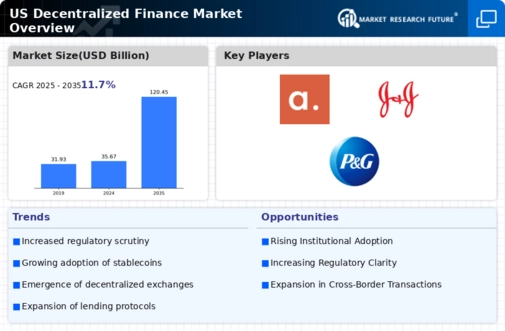Growing Demand for Financial Inclusion
The decentralized finance market is increasingly recognized for its potential to promote financial inclusion, particularly among underserved populations. In the US, approximately 14 million adults remain unbanked, highlighting a significant opportunity for decentralized finance solutions to provide access to financial services. By leveraging blockchain technology, decentralized finance platforms can offer low-cost, accessible financial products, such as lending and savings accounts, to individuals who lack traditional banking services. This growing demand for financial inclusion is likely to drive the expansion of the decentralized finance market, as more users seek alternatives to conventional banking systems.
Increased Focus on Security and Privacy
The decentralized finance market is placing a heightened emphasis on security and privacy. This focus is driven by growing concerns over data breaches and cyber threats. As the market matures, users are becoming more aware of the importance of safeguarding their assets and personal information. In response, decentralized finance platforms are implementing advanced security measures, such as multi-signature wallets and decentralized identity solutions. This focus on security is likely to enhance user trust and confidence in decentralized finance offerings, potentially leading to increased adoption and investment in the market.
Shift Towards Peer-to-Peer Transactions
The decentralized finance market is witnessing a notable shift towards peer-to-peer (P2P) transactions, which are facilitated by blockchain technology. This trend allows users to transact directly with one another without intermediaries, reducing costs and increasing transaction speed. In 2025, P2P transactions are expected to account for a significant portion of the decentralized finance market, as users increasingly prefer the autonomy and privacy that these transactions offer. This shift not only enhances user experience but also encourages the adoption of decentralized finance solutions, as individuals seek to leverage the benefits of direct transactions.
Technological Advancements in Blockchain
The decentralized finance market is experiencing rapid technological advancements in blockchain technology, which are pivotal for its growth. Innovations such as smart contracts and interoperability protocols enhance the functionality and efficiency of decentralized applications (dApps). In 2025, the market capitalization of blockchain technology is projected to reach approximately $1 trillion, indicating a robust interest in decentralized finance solutions. These advancements not only improve transaction speeds but also reduce costs, making decentralized finance more accessible to a broader audience. As more developers create innovative solutions, the decentralized finance market is likely to attract increased user engagement and investment, further solidifying its position in the financial ecosystem.
Emergence of Decentralized Autonomous Organizations (DAOs)
The decentralized finance market is witnessing the emergence of Decentralized Autonomous Organizations (DAOs). These organizations are transforming governance and decision-making processes within the ecosystem. DAOs enable users to participate in the management of decentralized finance platforms through token-based voting mechanisms. This shift towards community-driven governance is likely to enhance user engagement and foster a sense of ownership among participants. As DAOs gain traction, they may play a crucial role in shaping the future of the decentralized finance market, promoting transparency and inclusivity in decision-making.














Leave a Comment